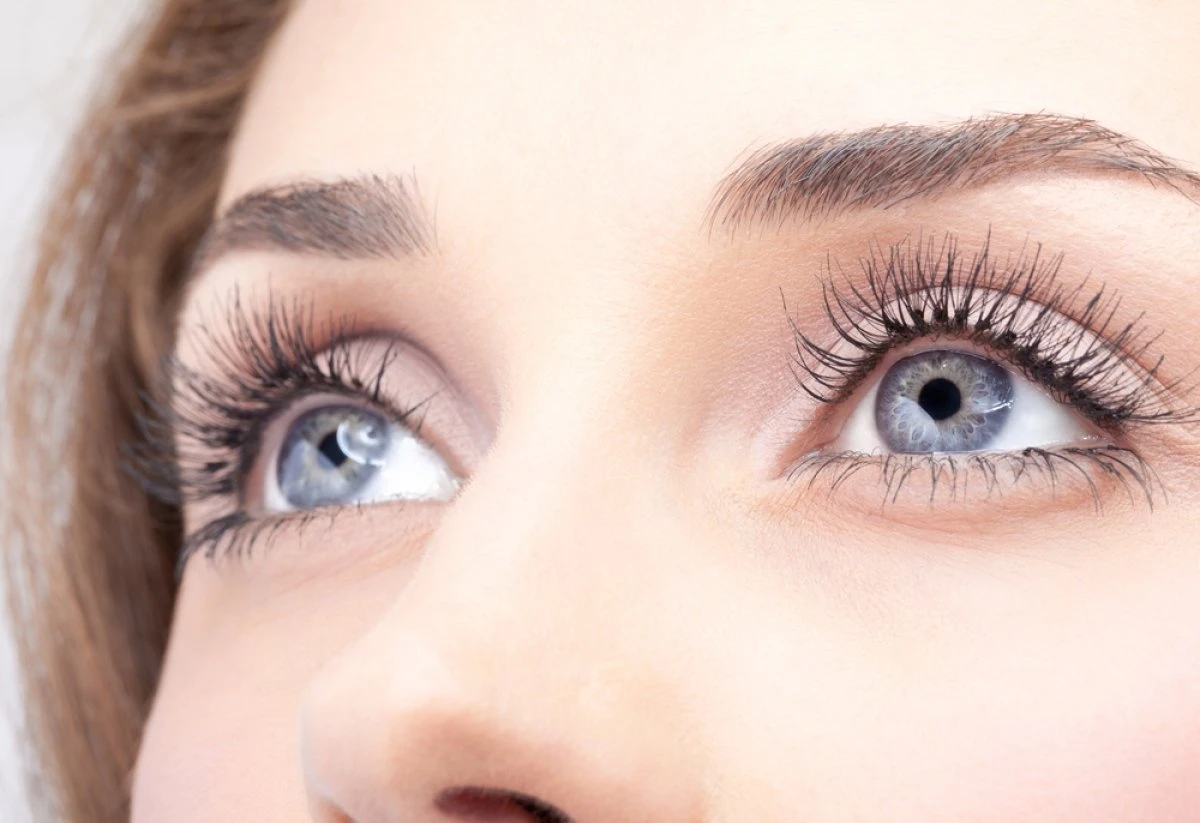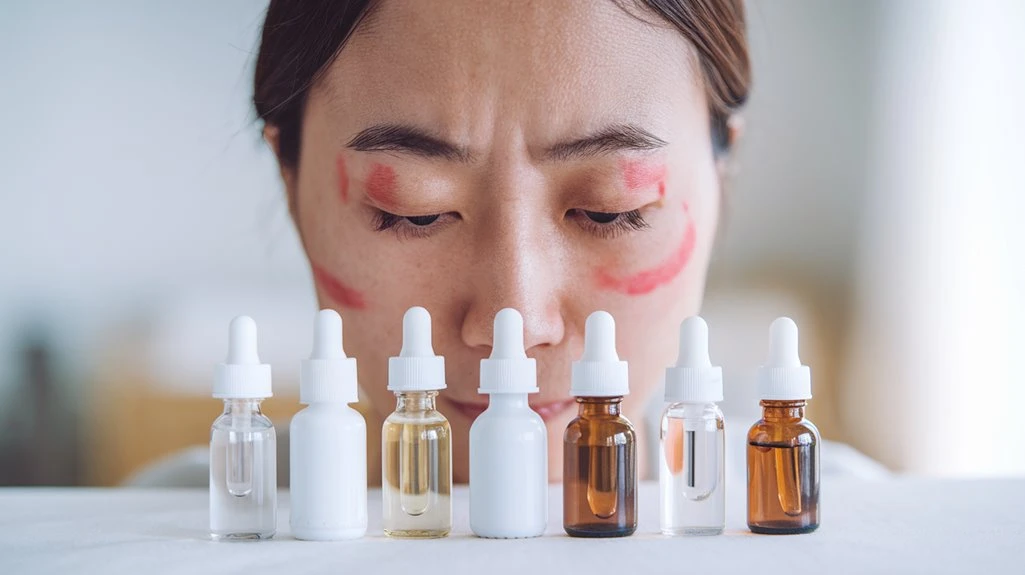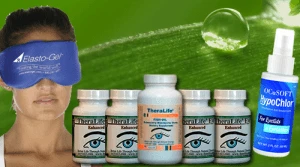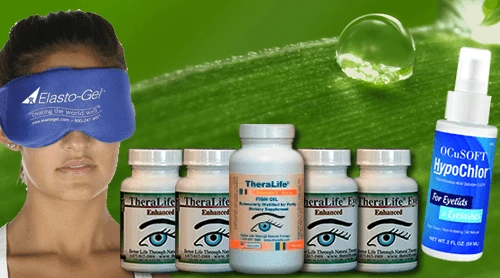If you’re managing eyelid inflammation, consider exploring TheraLife’s range of products designed to benefit customers with eye health concerns. TheraLife provides solutions that focus on addressing the root causes of common eye issues such as blepharitis and dry eyes. Their products, including artificial tears and lubricating eye drops, soothe dryness and discomfort, while specialized antihistamine drops target allergy-induced itching and redness. TheraLife emphasizes the importance of preservative-free choices for sensitive eyes, offering safer options for long-term use. Additionally, they provide sterile saline solutions to gently cleanse debris, and anti-redness drops for quick relief.
TheraLife also offers herbal formulations, promoting natural healing processes, although these may lack extensive clinical backing. By choosing TheraLife, customers can explore a variety of options tailored to their specific symptoms, maximizing ocular comfort and wellness. Whether managing eyelid inflammation or seeking comprehensive eye care, TheraLife’s products are crafted to provide effective relief and support for overall eye health.
Best Blepharitis Treatment From TheraLife- When Drops Don’t Work.
Key Takeaways
- Preservative-free artificial tears and lubricating drops like Refresh or Systane help soothe mild irritation and support healing without risk of increased inflammation.
- Antihistamine drops such as ketotifen (Zaditor, Alaway) or olopatadine (Pataday) effectively relieve itching and redness in allergy-related eyelid inflammation.
- Preservative-free saline solutions are safe for gentle eyelid cleansing and removing crusting, reducing further irritation during episodes of inflammation.
- Eye drops containing carboxymethylcellulose or hypromellose provide lasting moisture and symptom relief for chronic blunt inflammation or meibomian gland dysfunction.
- Avoid anti-redness drops for ongoing use, as they may worsen irritation; always consult a pharmacist or eye doctor for product selection.
Artificial Tears for Soothing Irritated Eyelids
Although artificial tears are commonly recommended for mild ocular discomfort, these lubricating eye drops don’t directly reduce eyelid inflammation.
Instead, artificial tears provide symptomatic relief by enhancing the tear film, diluting inflammatory mediators, and flushing away debris. You can choose from several artificial tears types, such as preservative-free formulations ideal for frequent application or more viscous gels that prolong ocular surface hydration.
Evidence supports artificial tears benefits in improving subjective comfort, reducing ocular surface stress, and supporting the ocular barrier, but they don’t address underlying inflammatory mechanisms of eyelid tissue. For individuals with eyelid irritation secondary to dry eyes, using an appropriate artificial tears type helps mitigate burning, grittiness, and transient redness, offering temporary relief and enhancing overall ocular surface health without treating the root inflammatory process.
Additionally, chronic dry eyes can lead to severe complications like blepharitis and MGD, which are often related to underlying inflammatory conditions.
Lubricating Eye Drops for Daily Relief
Beyond artificial tears, lubricating eye drops play a significant role in managing daily eyelid discomfort by maintaining consistent moisture on the ocular surface.
When you’re dealing with chronic blepharitis or meibomian gland dysfunction, the tear film’s stability is essential for reducing friction and supporting eye comfort.
Lubricating drops—typically containing carboxymethylcellulose, hypromellose, or glycerin—are formulated to provide longer-lasting relief than simple artificial tears.
These agents supplement your natural tear layer, ensuring daily hydration and minimizing epithelial cell stress.
Studies indicate regular use of lubricating eye drops can decrease the frequency and severity of inflammation-related symptoms, such as burning, foreign body sensation, and dryness.
For ideal daily relief, select preservative-free formulations to minimize potential chemical irritants, especially with frequent application.
Consistent use promotes overall ocular surface health.
It is also important to address gland dysfunction as it can significantly contribute to dry eye symptoms and impact the effectiveness of ocular surface treatments.
Antihistamine Drops to Reduce Allergy Symptoms
You’ll often find antihistamine drops containing active ingredients like ketotifen or olopatadine, which block histamine receptors to manage allergic conjunctivitis. These formulations effectively reduce ocular itching and conjunctival hyperemia, providing symptomatic relief during allergy flare-ups. Protective eyewear acts as a barrier against allergens like pollen, further complementing the relief provided by antihistamine drops. Always follow recommended dosing guidelines to minimize risks such as rebound redness or ocular irritation.
Common Antihistamine Drop Ingredients
Since allergic reactions often contribute to eyelid inflammation, over-the-counter antihistamine eye drops can play an essential role in symptom management.
Understanding the common active ingredients helps you evaluate antihistamine efficacy and ingredient safety before using these products. Here are three primary ingredients you’ll encounter:
- Ketotifen fumarate: This dual-acting antihistamine and mast cell stabilizer is widely used for its proven ability to block histamine receptors and prevent further release, reducing inflammatory responses.
- Pheniramine maleate: Effective at antagonizing histamine at H1 receptors, this ingredient reduces allergic symptoms rapidly but may cause minor stinging upon application.
- Olopatadine hydrochloride: Renowned for both safety and potency, olopatadine is frequently recommended for its low irritation profile and robust inhibition of ocular allergic pathways.
Choosing drops with clinically validated ingredients guarantees symptom relief and user safety. Additionally, Dry Eye Syndrome can often accompany eyelid inflammation, necessitating comprehensive treatment approaches that address multiple symptoms and underlying causes.
Best Blepharitis Treatment From TheraLife- When Drops Don’t Work.
Reducing Itching and Redness
Although eyelid inflammation frequently results in persistent itching and redness, over-the-counter antihistamine drops target these symptoms by directly inhibiting histamine-mediated pathways within the ocular surface.
When allergens activate local mast cells, histamine release leads to vasodilation and increased vascular permeability, intensifying pruritus and hyperemia. Antihistamine drops act at the H1 receptor, mitigating this inflammatory cascade and improving patient comfort.
For individuals prone to allergic conjunctivitis or those with compromised eyelid hygiene, these drops offer prompt symptom relief and help break the cycle of inflammation.
Identifying and minimizing inflammation triggers—such as pollen, dust mites, or cosmetic products—remains essential. It is important to note that red eyes can indicate non-serious issues if no pain or vision changes occur, but persistent symptoms should prompt consultation with a healthcare provider.
Safe Usage Guidelines
Before initiating antihistamine eye drops for eyelid inflammation, assess individual allergy history and medication tolerability, as these agents may provoke local irritation or exacerbate pre-existing ocular surface disease.
To guarantee safe application and ideal outcomes, you should carefully adhere to established dosage recommendations and avoid exceeding the manufacturer’s advised use.
- Safe Application Protocol: Prior to instillation, wash your hands thoroughly and avoid contact between the dropper tip and the ocular surface to prevent contamination.
- Dosage Recommendations: Use the minimum effective frequency, typically one to two drops per affected eye, up to four times daily, unless otherwise directed.
- Monitor Adverse Effects: Observe for worsening redness, increased irritation, or diminished vision, and discontinue drops if severe reactions arise.
In addition to antihistamine drops, using hot compresses can help alleviate symptoms of eyelid inflammation by unclogging meibomian glands, promoting normal function.
Always consult with your healthcare provider for personalized guidance.
Preservative-Free Options for Sensitive Eyes
If you have sensitive eyes, you’ll benefit from preservative-free drops, which minimize epithelial toxicity and reduce the risk of chronic irritation. Chemical preservatives, especially benzalkonium chloride, frequently trigger hypersensitivity reactions and exacerbate inflammation. To maximize efficacy and safety, make sure you avoid contaminating the dropper and follow single-use vial instructions. Using hypochlorous acid-based cleansers can further enhance eye comfort by preventing bacterial re-attachment, making them suitable for sensitive eyes.
Benefits of Preservative-Free
When selecting artificial tears or lubricating eye drops for eyelid inflammation, choosing preservative-free formulations reduces the risk of toxic or allergic reactions, particularly in individuals with sensitive ocular tissue. Preservatives, such as benzalkonium chloride (BAK), are linked to epithelial toxicity, tear film instability, and exacerbation of pre-existing ocular surface disease. For those with eye sensitivity, the preservative benefits of avoiding chronic chemical exposure can’t be overstated. Consider the following clinical advantages of preservative-free eye drops:
- Reduction in cumulative ocular surface damage and inflammation, often observed with chronic preservative use.
- Lower incidence of contact allergy, especially significant in patients with atopic or reactive conjunctiva.
- Preservation of tear film homeostasis and improved patient comfort, supporting long-term adherence to therapy.
Select preservative-free options for ideal ocular safety. TheraLife Omega-3, with its purified via molecular distillation process, ensures the removal of impurities such as mercury, providing a safe and high-quality supplement beneficial for eye health.
Common Irritation Causes
Many individuals experience eyelid inflammation due to a constellation of factors, including environmental allergens, meibomian gland dysfunction, and irritants present in skincare or cosmetic products.
You may also encounter inflammation from exposure to environmental irritants such as dust, pollen, or smoke, which compromise the ocular surface and trigger an immune response.
In addition, frequent use of cosmetics or facial cleansers with harsh chemicals can disrupt eyelid barrier function, leading to redness and edema.
Common eye infections, including blepharitis and conjunctivitis, exacerbate inflammation by introducing bacterial or viral pathogens into the delicate periocular tissues.
For those with heightened sensitivity, even trace preservatives in eye drops or artificial tears may provoke irritation, emphasizing the need for preservative-free formulas designed for sensitive eyes to reduce risk.
Using anti-inflammatory agents can help alleviate irritation and inflammation associated with dry eye conditions.
Safe Application Tips
One key strategy for managing eyelid inflammation—especially for patients with heightened sensitivity—involves selecting preservative-free eye drops and adhering to meticulous application techniques.
Preservative-free formulations reduce the risk of exacerbating inflammation triggers, particularly in patients who exhibit intolerance to common additives. These drops minimize exposure to potentially irritating substances, supporting ideal eyelid hygiene and ocular surface integrity.
To maximize therapeutic efficacy and safety, always follow these guidelines:
- Ensure proper hand hygiene: Wash hands thoroughly before administering drops to prevent introducing pathogens to the periocular area.
- Avoid touching the applicator tip: This reduces the risk of contaminating the solution and worsening eyelid inflammation.
- Apply drops as directed: Adhere to manufacturer or healthcare provider recommendations to maintain effective dosing and reduce recurrence of inflammation triggers.
In addition to preservative-free eye drops, considering alternative treatments like oral supplements such as TheraLife Eye capsules may help enhance tear production and alleviate dry eye symptoms.
Careful technique supports healthier, comfortable eyelids.
Sterile Saline Solutions for Gentle Cleansing
Although eyelid inflammation often requires targeted treatment, sterile saline solutions offer a gentle method for removing debris, crusting, and irritants from the periocular area. If you’re seeking to optimize eyelid hygiene, using a saline solution can mechanically clear particulate matter and dilute inflammatory mediators without introducing harsh chemicals. Saline irrigation supports microbial balance while minimizing risk of further irritation or allergic reactivity. It’s especially effective as a preparatory step before applying medicated therapies, ensuring the eyelid surface is unobstructed. Using preservative-free, sterile saline prevents exposure to additives that may exacerbate symptoms.
| Benefit | Clinical Rationale |
|---|---|
| Debris removal | Facilitates particulate clearance |
| Reduces crusting | Softens dried secretions for gentle removal |
| Maintains surface health | Preserves delicate periocular tissue integrity |
| Hypoallergenic profile | Minimizes sensory or immunologic irritation |
Anti-Redness Drops for Inflamed Eyelids
If you’re evaluating over-the-counter options for eyelid inflammation, it’s essential to distinguish between therapies targeting vascular congestion and those remedying surface pathology.
Anti-redness drops primarily act via vasoconstriction to reduce conjunctival hyperemia, but these don’t address the underlying cause of eyelid inflammation.
For best eyelid care and inflammation relief, you should consider the following:
- Temporary symptom relief: Anti-redness drops provide short-term reduction in redness, but prolonged use can cause rebound hyperemia.
- Targeting vascular congestion: Such drops specifically address blood vessel dilation, which may not correlate with eyelid pathology itself.
- Adjunct role: While these drops can enhance cosmesis, they shouldn’t replace therapies meant to treat blepharitis, meibomian gland dysfunction, or other structural causes of eyelid inflammation.
For safer and more effective eyelid care, consult an eye care professional.
Herbal and Natural Eye Drops for Inflammation
While many over-the-counter products position herbal and natural eye drops as gentle remedies for inflammation, current clinical evidence doesn’t support their efficacy or safety for eyelid disorders.
If you’re considering herbal remedies containing natural ingredients such as chamomile, euphrasia, or calendula, recognize that rigorous clinical trials evaluating these products are lacking. Most available studies either have small sample sizes or inadequate methodology, making it difficult to draw reliable conclusions on their anti-inflammatory effects.
Additionally, these natural ingredients can introduce potential allergens or contaminants, increasing your risk of adverse events like irritation, allergic reactions, or even worsening inflammation.
If you have inflamed eyelids, it’s critical to understand that herbal remedies aren’t recognized as proven therapies. Consult your ophthalmologist before using any non-prescription or natural eye drops.
Best Blepharitis Treatment From TheraLife- When Drops Don’t Work.
Frequently Asked Questions
Can Eyelid Inflammation Be a Sign of an Underlying Health Condition?
You should recognize that eyelid inflammation, or blepharitis, might indicate an underlying health condition.
Allergic reactions often trigger eyelid swelling and redness, but chronic conditions such as seborrheic dermatitis, rosacea, or autoimmune disorders can also manifest this symptom.
Clinical evidence shows that persistent inflammation warrants further evaluation, as it may signal infection, gland dysfunction, or systemic disease.
Always consult your healthcare provider for accurate diagnosis and evidence-based management.
How Long Should I Use Over-The-Counter Drops Before Seeing Improvement?
When you’re treating eyelid inflammation with over-the-counter drops, the eyelid inflammation duration and drop effectiveness timeline usually range from a few days to one week.
You should observe some symptom relief within 48-72 hours, but complete resolution might take up to seven days.
If you don’t notice improvement after one week, or if symptoms worsen, consult a healthcare provider, as persistent inflammation may indicate a more serious underlying pathology requiring further evaluation or prescription therapy.
Are There Lifestyle Changes That Can Help Prevent Eyelid Inflammation?
You can reduce your risk of eyelid inflammation by implementing dietary adjustments—prioritize omega-3 fatty acids found in fish and flaxseed, as research shows they support eyelid gland function and reduce inflammation.
Maintain proper eyelid hygiene and avoid rubbing your eyes.
Stress management is vital; chronic stress disrupts immune regulation and may exacerbate inflammation.
Evidence indicates that mindfulness techniques and regular exercise can modulate inflammatory pathways, promoting overall ocular surface health.
Can Children Safely Use Over-The-Counter Eye Drops for Eyelid Inflammation?
Like Alice traversing Wonderland, you should tread carefully when considering pediatric use of over-the-counter eye drops for eyelid inflammation.
Safety concerns are paramount; children’s ocular surface and immune responses differ from adults. Not all formulations are approved for use in young patients.
Always consult a pediatric ophthalmologist before administration. They’ll evaluate risks, potential adverse effects, and therapeutic alternatives, ensuring you choose the safest evidence-based approach for your child’s unique needs.
Best Blepharitis Treatment From TheraLife
Add To Cart
When Should I Consult a Doctor Instead of Using OTC Drops?
You should consult a doctor if symptom severity increases, you notice vision changes, severe pain, persistent redness, or discharge despite using OTC drops.
Don’t delay if symptoms last over a week or worsen, because complications like infection or underlying disease require prompt evaluation.
A physician can assess differential diagnoses and recommend evidence-based treatment options, such as prescription medications or laboratory testing, ensuring you address the underlying cause and prevent long-term ocular complications.
Best Blepharitis Treatment From TheraLife
Add To Cart
Conclusion
Explore the benefits of TheraLife.com’s products for eyelid inflammation and dry eye conditions. TheraLife offers a range of natural and effective solutions tailored to combat various eye health issues, including blepharitis, uveitis, and dry eyes associated with Sjögren’s syndrome and rheumatoid arthritis. Their products focus on addressing underlying causes rather than just symptoms, enhancing overall eye health.
By using TheraLife’s comprehensive approach, customers can experience relief from inflammation, dryness, and discomfort. The products are designed to complement lifestyle and dietary adjustments, promoting long-term eye wellness. Whether dealing with crusty eyes, recurrent chalazions, or the challenges of aging eyes, TheraLife provides evidence-based, natural alternatives. For those enduring the persistent effects of eye conditions, consulting with TheraLife ensures a holistic path to improved ocular health.





